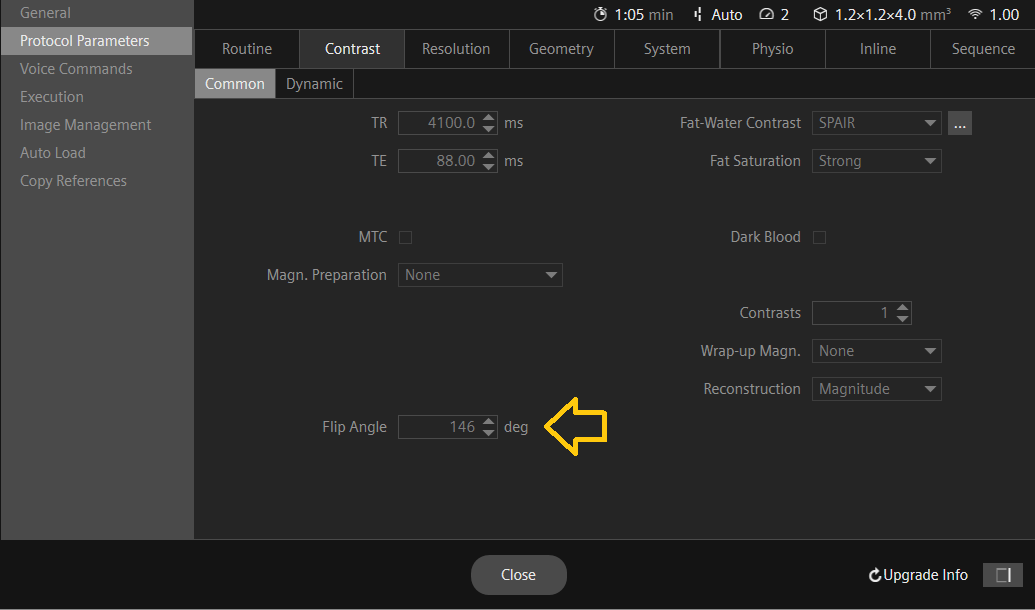MRI Flip Angle and Image Quality
Flip angle
In magnetic resonance imaging (MRI), the flip angle refers to the angle at which the magnetic field is applied to the protons within the body under examination. This angle governs the energy transfer to the protons and subsequently influences the signal intensity displayed in the resulting MRI image. A greater flip angle corresponds to a heightened signal intensity, resulting in a brighter image. Conversely, a smaller flip angle yields a reduced signal intensity, leading to a darker image. The physics behind the flip angle in MRI can be understood by considering the interaction between the magnetic field and the nuclear spins.
The magnetic field in MRI is generated by a combination of a static magnetic field (B0) and time-varying magnetic fields (B1) that are used to excite and detect the nuclear spins. The B1 field is typically applied perpendicular to the B0 field, which causes the nuclear spins to precess around the B0 field axis at a specific frequency, known as the Larmor frequency.
The flip angle is the angle through which the net magnetization vector is tipped from the longitudinal axis. This angle depends on the strength of the B1 field and the duration of the RF pulse. The relationship between these variables is described by the Bloch equations, which model how nuclear spins respond under magnetic influence.
As the nuclear spins rotate away from their equilibrium orientation, they absorb energy from the B1 field and generate a net magnetic moment in the transverse plane. This transverse magnetization is what is detected by the MRI machine to create an image.

Flip Angle and Signal-to-Noise Ratio (SNR)
When the flip angle is increased, the SNR of the image also increases, up to a certain point. This is because increasing the flip angle causes more protons to be excited and produce a stronger MRI signal. However, if the flip angle is too high, the image can become saturated, meaning that all the protons have been excited and there is no further signal increase. In this case, further increasing the flip angle will not result in a higher SNR and may even decrease the image quality due to artifacts.
Conversely, reducing the flip angle too much can lead to decreased SNR. This is because fewer protons are excited and the resulting MRI signal is weaker. In this case, the image may appear darker and have more noise.
An appropriate flip angle is crucial to achieving optimal SNR in MRI. The optimal flip angle depends on various factors such as the tissue being imaged, the imaging sequence used, and the desired trade-off between SNR and image contrast. Experienced MRI technicians or radiologists can select the optimal flip angle based on these factors to obtain the best possible image quality.
Flip angle 5

Flip angle 20

Flip angle 40

Flip angle 90

Flip angle and Specific Absorption Rate (SAR)
The flip angle in MRI can affect the Specific Absorption Rate (SAR), which is a measure of the amount of radiofrequency (RF) energy absorbed by the body during an MRI scan.
The RF energy used in an MRI scan is typically applied in pulses, and the flip angle determines the amount of RF energy that is absorbed by the body during each pulse. A higher flip angle results in a greater amount of RF energy being absorbed, which can increase the SAR.
References
- Haacke, E. M., Brown, R. W., Thompson, M. R., & Venkatesan, R. (2015). Magnetic resonance imaging: Physical principles and sequence design. John Wiley & Sons.
- Bernstein, M. A., King, K. F., & Zhou, X. J. (2004). Handbook of MRI pulse sequences. Academic Press.
- Cline, H. E. (1990). Nuclear magnetic resonance imaging: physical principles and sequence design. Radiology, 177(1), 239-247.


